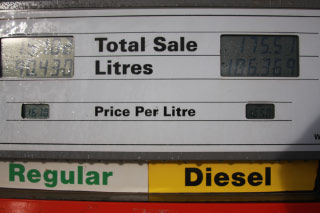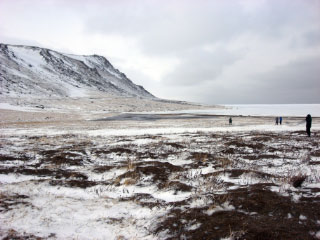Epilogue and Appendix.
Epilogue - Energy Crisis and Global Weirding
 (Bert)
Here in Breckenridge, Colorado, I am watching TV news coverage of Hurricane Ike
as I write this epilogue. Being a Texan and having property on Mustang Island
near Corpus Christi as well as more secure inland Texas sites, the hurricane
certainly has our attention. President Bush appeared on the news, warning gas
station owners not to price gouge. Yet, undoubtedly, fuel prices will rise with
the shutdown of refineries. Likely, the rest of the nation will see the type of
prices we paid this summer. Our lowest price for diesel was $4.569 per gallon in
Anchorage and the highest was $5.582 in Fort Nelson, BC, with an average of
$5.144. Fortunately we have a 150-gal. fuel tank and were able to pass up the
stations with prices hovering near $6 per gallon. Gasoline prices were typically
lower, but reached their peak on the Dempster Highway where we paid $6.764 in
Eagle Plains, YT. The high cost of fuel exaggerates the cost of other goods,
most noticeably groceries where remote areas sell fresh fruits and vegetables at
up to three times the price to which we are accustomed.
(Bert)
Here in Breckenridge, Colorado, I am watching TV news coverage of Hurricane Ike
as I write this epilogue. Being a Texan and having property on Mustang Island
near Corpus Christi as well as more secure inland Texas sites, the hurricane
certainly has our attention. President Bush appeared on the news, warning gas
station owners not to price gouge. Yet, undoubtedly, fuel prices will rise with
the shutdown of refineries. Likely, the rest of the nation will see the type of
prices we paid this summer. Our lowest price for diesel was $4.569 per gallon in
Anchorage and the highest was $5.582 in Fort Nelson, BC, with an average of
$5.144. Fortunately we have a 150-gal. fuel tank and were able to pass up the
stations with prices hovering near $6 per gallon. Gasoline prices were typically
lower, but reached their peak on the Dempster Highway where we paid $6.764 in
Eagle Plains, YT. The high cost of fuel exaggerates the cost of other goods,
most noticeably groceries where remote areas sell fresh fruits and vegetables at
up to three times the price to which we are accustomed.
Having spent 111 days this summer in Alaska and northern territories has
given me an excellent perspective to assess the enormous impact of the energy
crises on the economy, the environment, the fabric of society, and even global
unrest. I believe Americans are naďve in thinking fuel prices will come down or
even stabilize at their current numbers. There simply is not enough crude oil
reserves left in the world to handle the world’s increasing demand. With the
U.S. Presidential campaign now waging, there is talk of more drilling, yet
virgin oil fields in ANWR, the National Petroleum Reserve Alaska and the Arctic
Ocean will not solve our energy needs
 because
reserves are too few, too remote, require new pipe lines and pose enormous and
likely disastrous effects on the pristine environment. Even if some of these
areas were tapped, we would not see crude oil at refineries for 10 years or
more. Clearly, we must be looking elsewhere from oil to other energy sources.
And those energy sources must be renewable and not further compounding global
warning.
because
reserves are too few, too remote, require new pipe lines and pose enormous and
likely disastrous effects on the pristine environment. Even if some of these
areas were tapped, we would not see crude oil at refineries for 10 years or
more. Clearly, we must be looking elsewhere from oil to other energy sources.
And those energy sources must be renewable and not further compounding global
warning.
In our travels we experienced firsthand the effects of global warming along
the coast of the Arctic Ocean: the changes in ice coverage, the collapse of
land, the shift and decline of Polar Bears, the decrease in whales and fish. A
frightening fact I learned on this trip is that the Arctic tundra covers peat -
the carbon-filled remnant of plant life that could not decay in the extreme cold
climate – and with global warming the peat will start to decay forming methane
that then is converted into carbon dioxide and water, further accelerating
global warming.
We also experienced the worst weather in the five Alaskan trips we have made
since 1996. As pointed out by Tom Friedman in his new book Hot, Flat, and
Crowded, global warming should really be named global weirding. Early in our
trip we constantly heard spring was two weeks late, in July we waited for summer
but it must have come one afternoon while I was napping because I didn’t see it,
and in August local people said fall was two weeks early as we endured freezing
nighttime temperatures. It was a cold 111 days without a summer. Prior visits to
Alaska were mostly dry weather, but this year we endured rain on most days.
Global Weirding aptly describes our experience, and seems also to fit this
season’s hurricanes as I continue to watch Hurricane Ike pounding Texas.
Appendix – Mileage and Fuel Costs
Here are some statistics for this trip:
Trip length: 111 days from start on Alaska Highway to end at Hyder, AK
Miles driven by RV: 5255
Miles driven by car, including Dempster Highway: 2311
Diesel fuel (which includes running our generator for electricity): $4121
Gasoline, including Dempster Highway: $645
To get to our rendezvous point we started from Port Aransas, Texas, and
traveled via Wisconsin for an additional 9589 mi. On our return from Hyder, AK,
we reached Breckenridge, CO, in 8 days, traveling another 2314 mi. Our total RV
mileage so far in 2008 is 17,580.
Appendix - Mammal and Bird Sightings
Animal species identified:
Birds in Canada: 150
Birds in Alaska: 204
Birds throughout: 242 --- full list as PDF file

Mammals in Canada: 24
Mammals in Alaska: 36
Mammals throughout: 43 --- detailed list as PDF file

Year to date, I have identified 860 bird species this year in my travels.
Of the 43 mammal species we saw on our trip, I was most impressed with the
number of bears we encountered, seeing Grizzly Bears on 10 days and Black Bears
on 16 days. Here is the list in order of increasing sightings:
Species (Days, Min, Max, Total)
Bearded Seal (1, 1, 1, 1)
Ringed Seal (1, 1, 1, 1)
Ribbon Seal (1, 1, 1, 1)
Canadian Lynx (1, 1, 1, 1)
American Mink (1, 1, 1, 1)
Collared Pika (1, 1, 1, 1)
Northern Red-backed Vole (1, 1, 1, 1)
Northern Bog Lemming (1, 1, 1, 1)
White-tailed Deer (1, 1, 1, 1)
Alaskan Hare (1, 6, 6, 6)
Meadow Vole (2, 1, 1, 2)
Harbor Porpoise (2, 1, 2, 3)
Northern River Otter (2, 1, 5, 6)
Elk (2, 5, 9, 14)
Fin Whale (2, 2, 13, 15)
Steller's Sea Lion (2, 20, 50, 70)
Dall's Porpoise (3, 1, 10, 21)
Bison (3, 1, 25, 27)
Brown Lemming (3, 1, 30, 36)
Muskox (3, 4, 43, 77)
Ermine (4, 1, 1, 4)
Coyote (4, 1, 1, 4)
Gray Wolf (4, 1, 3, 6)
Porcupine (4, 1, 5, 8)
Muskrat (5, 1, 1, 5)
Harbor Seal (5, 1, 2, 8)
Least Chipmunk (5, 1, 3, 8)
Gray Whale (5, 1, 10, 18)
Tundra Vole (5, 1, 10, 24)
Humpback Whale (5, 1, 20, 37)
Beaver (6, 1, 1, 6)
Hoary Marmot (6, 1, 5, 12)
Mule Deer (7, 1, 5, 12)
Sea Otter (7, 3, 250, 410)
Grizzly Bear (10, 1, 11, 35)
Dall's & Stone Sheep (10, 1, 80, 222)
Red Fox (12, 1, 2, 14)
Black Bear (16, 1, 3, 22)
Caribou (17, 1, 50, 132)
Arctic Ground Squirrel (23, 1, 14, 73)
Snowshoe Hare (23, 1, 32, 114)
Red Squirrel (32, 1, 5, 53)
Moose (32, 1, 7, 79)
 Table
of Contents
Table
of Contents
 (Bert)
Here in Breckenridge, Colorado, I am watching TV news coverage of Hurricane Ike
as I write this epilogue. Being a Texan and having property on Mustang Island
near Corpus Christi as well as more secure inland Texas sites, the hurricane
certainly has our attention. President Bush appeared on the news, warning gas
station owners not to price gouge. Yet, undoubtedly, fuel prices will rise with
the shutdown of refineries. Likely, the rest of the nation will see the type of
prices we paid this summer. Our lowest price for diesel was $4.569 per gallon in
Anchorage and the highest was $5.582 in Fort Nelson, BC, with an average of
$5.144. Fortunately we have a 150-gal. fuel tank and were able to pass up the
stations with prices hovering near $6 per gallon. Gasoline prices were typically
lower, but reached their peak on the Dempster Highway where we paid $6.764 in
Eagle Plains, YT. The high cost of fuel exaggerates the cost of other goods,
most noticeably groceries where remote areas sell fresh fruits and vegetables at
up to three times the price to which we are accustomed.
(Bert)
Here in Breckenridge, Colorado, I am watching TV news coverage of Hurricane Ike
as I write this epilogue. Being a Texan and having property on Mustang Island
near Corpus Christi as well as more secure inland Texas sites, the hurricane
certainly has our attention. President Bush appeared on the news, warning gas
station owners not to price gouge. Yet, undoubtedly, fuel prices will rise with
the shutdown of refineries. Likely, the rest of the nation will see the type of
prices we paid this summer. Our lowest price for diesel was $4.569 per gallon in
Anchorage and the highest was $5.582 in Fort Nelson, BC, with an average of
$5.144. Fortunately we have a 150-gal. fuel tank and were able to pass up the
stations with prices hovering near $6 per gallon. Gasoline prices were typically
lower, but reached their peak on the Dempster Highway where we paid $6.764 in
Eagle Plains, YT. The high cost of fuel exaggerates the cost of other goods,
most noticeably groceries where remote areas sell fresh fruits and vegetables at
up to three times the price to which we are accustomed.  because
reserves are too few, too remote, require new pipe lines and pose enormous and
likely disastrous effects on the pristine environment. Even if some of these
areas were tapped, we would not see crude oil at refineries for 10 years or
more. Clearly, we must be looking elsewhere from oil to other energy sources.
And those energy sources must be renewable and not further compounding global
warning.
because
reserves are too few, too remote, require new pipe lines and pose enormous and
likely disastrous effects on the pristine environment. Even if some of these
areas were tapped, we would not see crude oil at refineries for 10 years or
more. Clearly, we must be looking elsewhere from oil to other energy sources.
And those energy sources must be renewable and not further compounding global
warning.